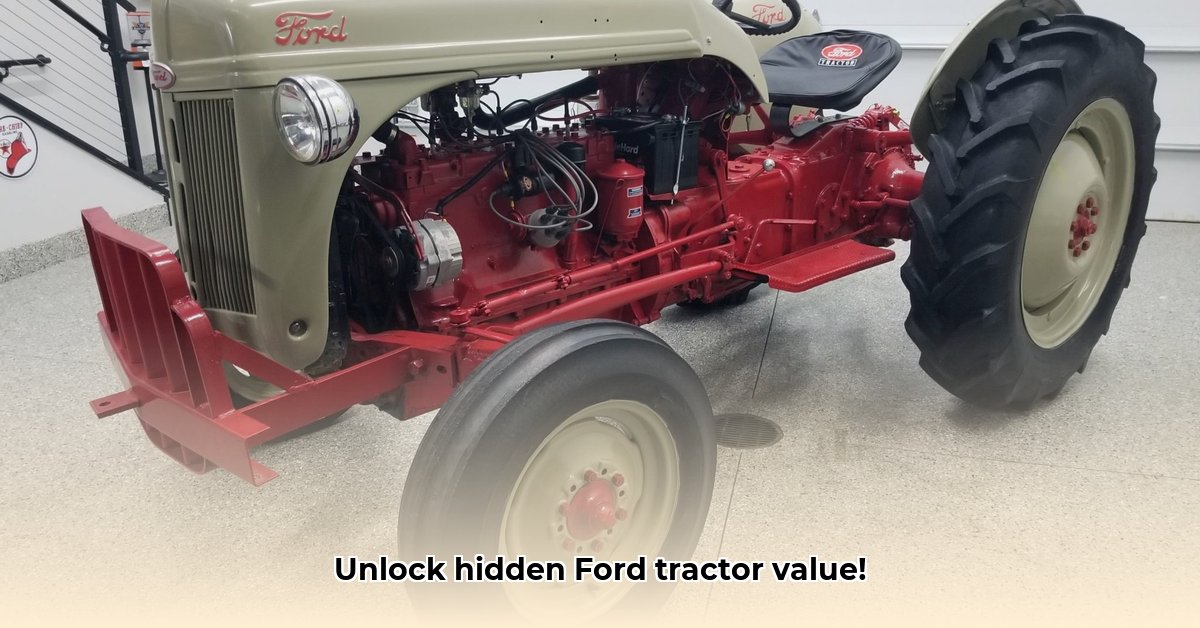
What Factors Determine a 1948 Ford Tractor's Value?
Determining the fair market value of a 1948 Ford tractor requires a nuanced understanding of several key factors. This isn't simply a case of looking up a price; it's about assessing a complex interplay of condition, model, location, and market trends. This guide will equip you with the knowledge to confidently navigate the world of classic tractor valuations. For more detailed information on Ford tractor values, check out this helpful resource: Ford Tractor Values.
Model and Year: Rarity and Desirability
Not all 1948 Ford tractors are created equal. Specific models, like the highly sought-after 8N, command significantly higher prices than less common variants. Rarity plays a crucial role, much like in the collectible car market. A unique or less-produced model can be far more valuable because of its scarcity. Therefore, precisely identifying your tractor's model and year is the first crucial step towards valuation.
Condition: The Single Biggest Factor
A tractor's condition exerts the most significant influence on its value. A meticulously restored 1948 Ford tractor, ready for a show, will command a price far exceeding a neglected machine sitting in a field for decades. The difference can easily run into thousands, even tens of thousands, of dollars. Think of it like the difference between a concours-winning classic car and one needing extensive restoration.
Assessing Condition: A Detailed Inspection
A thorough inspection is critical. This involves more than a quick glance; it requires a detailed examination of several key areas:
Exterior: Evaluate the paint, bodywork, and overall aesthetic condition. Look for rust, dents, and missing parts. Document everything with photographs.
Mechanical Function: Test the engine, transmission, hydraulics, and other vital systems. Are there any leaks, malfunctions, or signs of significant wear? Note any needed repairs.
Original Parts: Original components, especially hard-to-find parts, significantly enhance the tractor's value. Identify any replacements, noting their quality and whether they are original-equipment manufacturer (OEM) parts.
Location: Regional Demand and Shipping Costs
Geographic location impacts value because regional demand for vintage tractors varies considerably. Areas known for their rich agricultural history or active collector communities tend to have a higher demand. Conversely, less active markets may lead to lower prices. Furthermore, shipping costs for these heavy machines can be considerable; local buyers often have a price advantage.
Market Data: A Helpful, But Imperfect, Guide
Online resources and auction results provide valuable benchmarks but aren't definitive predictors of value. Auction prices tend to be higher than private sales, with the final hammer price influenced by competition and collector enthusiasm. Private sales prices offer less transparency but can give insights into a broader range of transactions. Always seek multiple data points for a complete picture.
How to Assess Your 1948 Ford Tractor Value: A Step-by-Step Guide
Now, let's consolidate our findings into a practical, step-by-step guide to determining your 1948 Ford tractor's value:
Identify the Model: Precisely identify the tractor model using resources like manuals or online databases.
Detailed Condition Assessment: Conduct a thorough visual and mechanical inspection, documenting everything using photographs and notes.
Market Research: Research comparable tractors sold recently (both auctions and private sales). Factor in condition, location, and included attachments.
Pricing Strategy: After compiling your data, establish a realistic price range, considering the upper and lower bounds of values you've observed.
Negotiating a Purchase or Sale: Tips for Success
Negotiating the price requires preparation. Your thorough assessment provides the foundation for a fair deal:
Be Informed: Support your price with data from your market research.
Transparency: Be completely transparent about the tractor's condition.
Professional Appraisal: For valuable tractors, a professional appraisal adds weight to your pricing strategy.
Where to Buy and Sell: Reputable Sources
Reliable sources for buying and selling include specialized online marketplaces, auctions (both online and live), and established agricultural equipment dealerships. Always exercise caution and verify sellers' credibility.
Long-Term Investment Strategy: Factors to Consider
Investing in classic tractors isn't a guaranteed path to wealth; market trends, maintenance, and storage costs factor significantly into long-term value. Researching market trends and understanding the potential for appreciation (or depreciation) is crucial for informed decision-making.
Conclusion: Navigating the 1948 Ford Tractor Market
The value of a 1948 Ford tractor is a complex calculation. By understanding the key influencing factors, conducting thorough research, and approaching negotiations systematically, whether buying or selling, you can make well-informed decisions and navigate this niche market with confidence. Remember to always verify information and seek expert advice when dealing with high-value transactions.